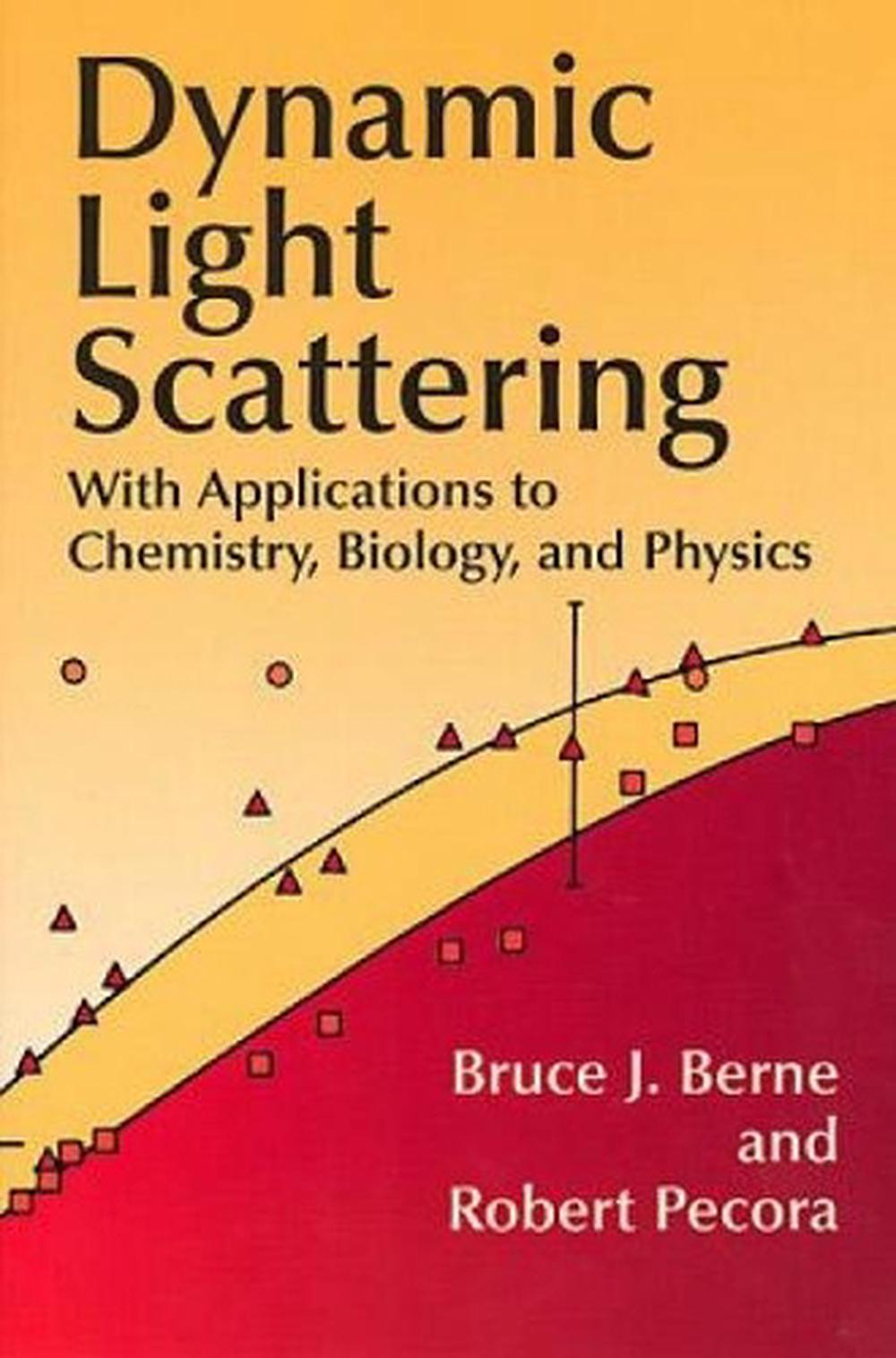
Dynamic Light Scattering
by Bruce J. Berne
This comprehensive introduction to principles underlying laser light scattering focuses on time dependence of fluctuations in fluid systems; also serves as introduction to theory of time correlation functions. 1976 edition.
Paperback
English
Brand New
Publisher Description
Lasers play an increasingly important role in a variety of detection techniques, making inelastic light scattering a tool of growing value in the investigation of dynamic and structural problems in chemistry, biology, and physics. Until the initial publication of this work, however, no monograph treated the principles behind current developments in the field.This volume presents a comprehensive introduction to the principles underlying laser light scattering, focusing on the time dependence of fluctuations in fluid systems; it also serves as an introduction to the theory of time correlation functions, with chapters on projection operator techniques in statistical mechanics. The first half comprises most of the material necessary for an elementary understanding of the applications to the study of macromolecules, or comparable sized particles in fluids, and to the motility of microorganisms. The study of collective (or many particle) effects constitutes the second half, including more sophisticated treatments of macromolecules in solution and most of the applications of light scattering to the study of fluids containing small molecules.With its wide-ranging discussions of the many applications of light scattering, this text will be of interest to research chemists, physicists, biologists, medical and fluid mechanics researchers, engineers, and graduate students in these areas.
Table of Contents
Preface Chapter 1 Introduction 1.1 Historical Sketch 1.2 Synopsis Chapter 2 Light Scattering and Fluctuations 2.1 Introduction 2.2 Fluctuations and Time-Correlation Functions 2.3 Ensemble-Averaged Time-Correlation Functions 2.4 The Spectral Density Chapter 3 Basic Light Scattering Theory 3.1 Introduction 3.2 Results from Electromagnetic Theory 3.3 Molecular Approach to Light Scattering 3.4 Scattering Geometries Appendix 3.A Derivation of the Scattered Field Chapter 4 The Light Scattering Experiment 4.1 Introduction 4.2 Filter Techniques 4.3 Optical Mixing Techniques Appendix 4.A Fabry-Perot Interferometer Appendix 4.B Optical Mixing Experiments Appendix 4.C The Gaussian Approximation Chapter 5 Model Systems of Spherical Molecules 5.1 Introduction 5.2 Spherical Molecules 5.3 Dilute Solutions and Particle Independence 5.4 Heterodyne Correlation Function for Particle Diffusion 5.5 Homodyne Spectrum for Very Dilute Solutions 5.6 Dilute Gases 5.7 Motile Microorganisms 5.8 Molecules in Uniform Motion 5.9 Brownian Motion Appendix 5.A The Calculation of the Mean-Square Displacement Chapter 6 Fluctuations in Chemically Reacting Systems 6.1 Introduction 6.2 Formulation of Model 6.3 Electrophoresis: The Fast and Slow Exchange Limits 6.4 No External Fields 6.5 Dimerization Kinetics 6.6 Fluorescence Correlations 6.7 Prospects Appendix 6.A The Derivation of the Equation of FFS Chapter 7 Model Systems Containing Optically Anisotropic Molecules 7.1 Introduction 7.2 Scattering from Cylindrically Symmetric Molecules 7.3 Rotational Diffusion of Linear Molecules 7.4 Scattering from Anisotropic Molecules 7.5 Rotational Diffusion of Anisotropic Molecules 7.6 Extended Diffusion Models for Molecular Reorientation 7.7 Macromolecules in Solution 7.8 Application to Small Molecules in Liquids Appendix 7.A The Coupling Between Translational and Rotational Diffusion in Dilute Solutions Appendix 7.B An Alternative Treatment of Symmetric Top Molecules Appendix 7.C Irreducible Tensors in Light Scattering Chapter 8 Scattering from Very Large Molecules 8.1 Introduction 8.2 Angular Distributions of Isotropic Integrated Intensities 8.3 Molecules of Arbitrary Shape 8.4 Molecular Weight Determinations 8.5 Corrections for Finite Concentrations and Polydispersity 8.6 Time-Correlation Functions and Spectral Distributions 8.7 The Correlation Function for Long Rigid Rods 8.8 Gaussian Coils 8.9 Anisotropic Scattering 8.10 Other Models 8.11 Effects of Polydispersity on Time-Correlation Functions and Spectra 8.12 Large Particles Appendix 8.A The Fokker-Planck Equation Appendix 8.B Form Factor for the Optically Anisotropic Rigid Rod Chapter 9 Electrolyte Solutions 9.1 Introduction 9.2 The Diffusion Equation of a Strong Electrolyte 9.3 External Fields-Electrophoresis 9.4 Macroions 9.5 The Equilibrium Structure Factors Chapter 10 Light Scattering from Hydrodynamic Modes 10.1 Introduction 10.2 Relaxation Equations and the Regression of Fluctuations 10.3 Conservation Equations and Hydrodynamic Modes 10.4 The Rayleigh-Brillouin Spectrum of a Pure Monatomic Fluid 10.5 The Rayleigh-Brillouin Spectrum and Intramolecular Relaxation 10.6 Binary Mixtures 10.7 Critical Opalescence Appendix 10.A Ensemble Theory of Fluctuations Appendix 10.B Thermodynamic Identities Appendix 10.C Thermodynamic Fluctuation Theory Chapter 11 Methods for Deriving Relaxation Equations 11.1 Introduction 11.2 Liouville Space 11.3 Projection Operators and Relaxation Equations 11.4 Slow and Fast Variables 11.5 Symmetry Properties of the Relaxation Equations 11.6 Relaxation of a Single Conserved Variable Appendix 11.A Projection Operators in Quantum Statistical Mechanics Appendix 11.B An Expression for the Relaxation Rate in Terms of Ordinary Time-Correlation Functions Appendix 11.C Additional Theorems Concerning Time-Correlation Functions and Memory Functions Chapter 12 Cooperative Effects in Depolarized Light Scattering 12.1 Introduction 12.2 Kinetic Equations for Orientational Relaxation in Depolarized Scattering 12.3 Comparison Between Single Particle and Collective Reorientation Times Chapter 13 Nonequilibrium Thermodynamics-Diffusion and Electrophoresis 13.1 Introduction 13.2 The Equation of Entropy Balance 13.3 Calculation of the Entropy Production 13.4 The Phenomenological Equations 13.5 Isothermal Diffusion of Uncharged Molecules in a Two-Component System 13.6 Isothermal Diffusion in an Uncharged Multicomponent System 13.7 Electrolyte Solutions 13.8 Electrophoretic Fluctuation Theory Chapter 14 Collision-Induced Light Scattering and Light Scattering by Gases 14.1 Introduction 14.2 A Simple Collisional Model 14.3 The Kinetic Theory of Gases Chapter 15 Other Probes of Molecular Dynamics 15.1 Introduction 15.2 Neutron Scattering 15.3 Raman and Infrared Band Shapes 15.4 Dielectric Relaxation 15.5 Other Methods
Long Description
This comprehensive introduction to principles underlying laser light scattering focuses on time dependence of fluctuations in fluid systems; also serves as introduction to theory of time correlation functions. 1976 edition.
Details

